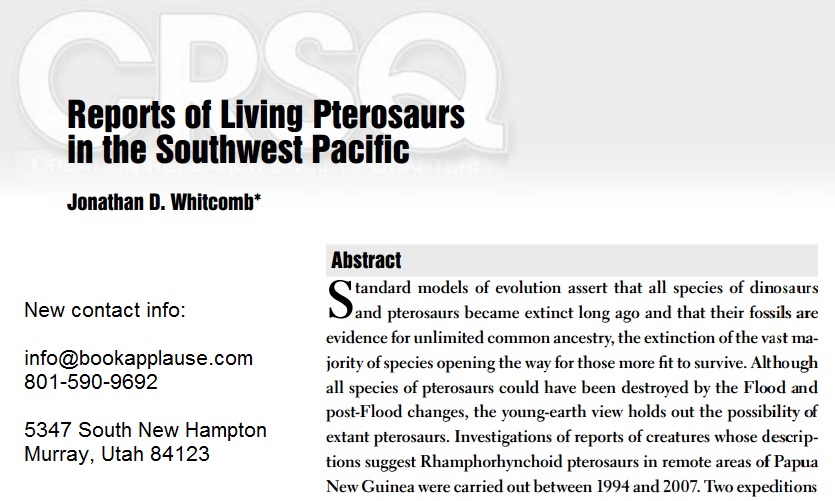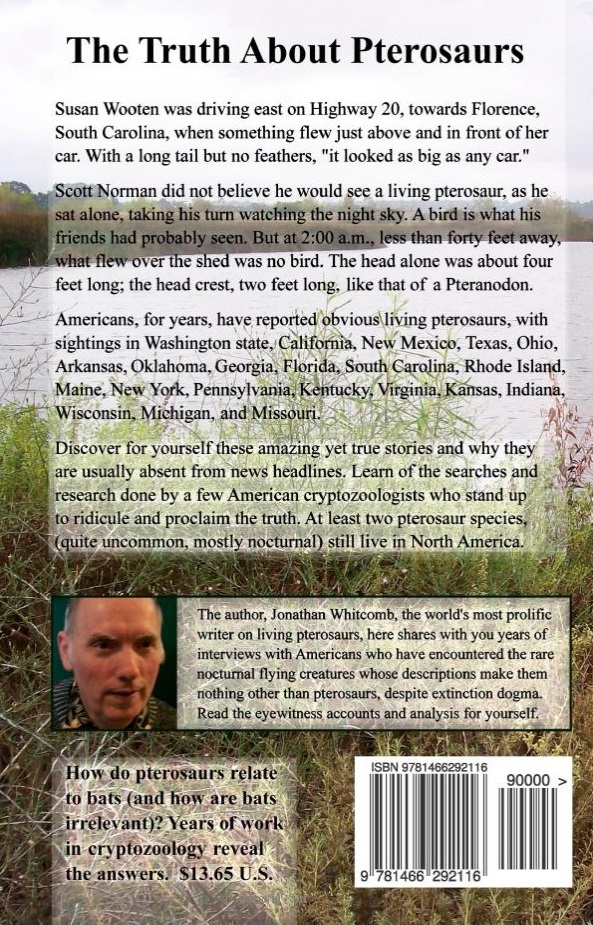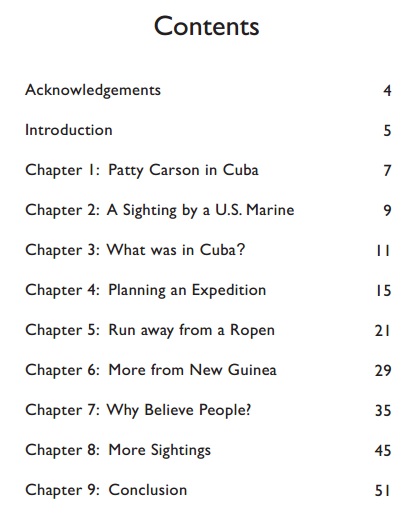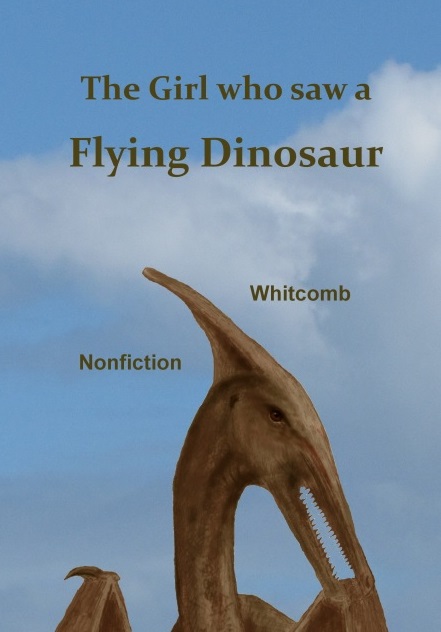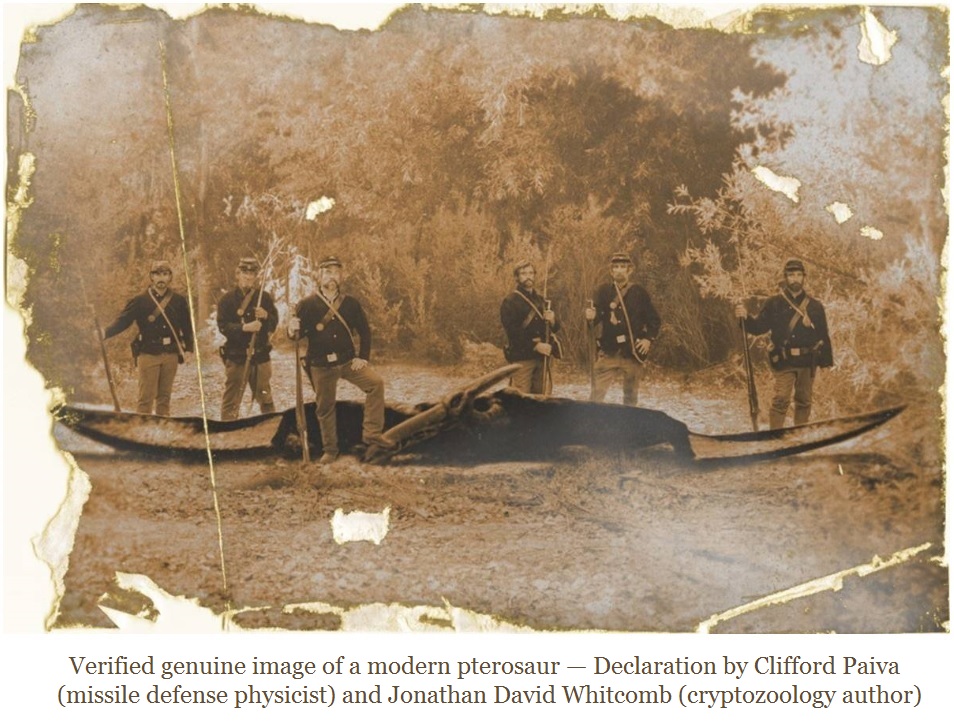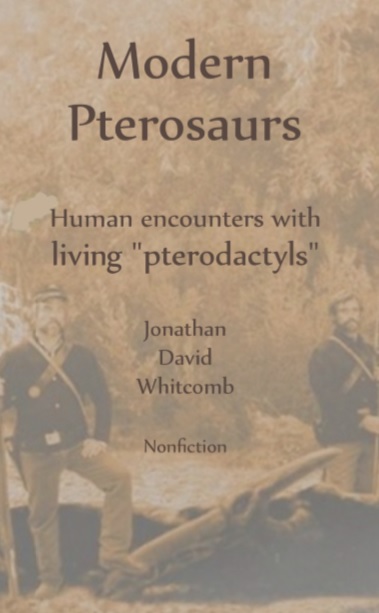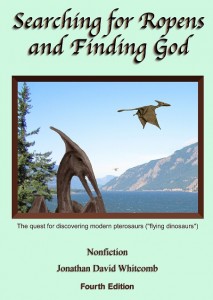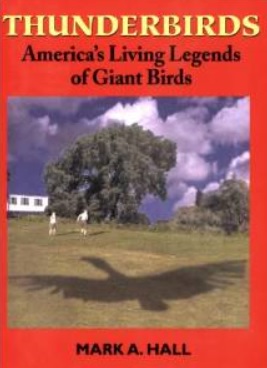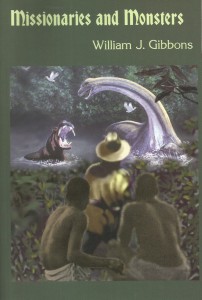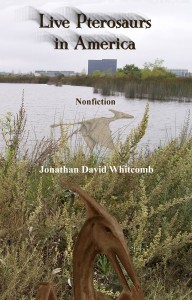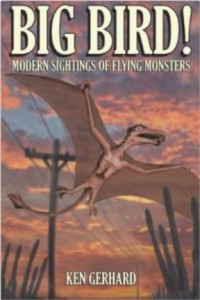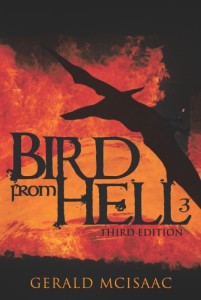Scientific Paper on Modern Pterosaurs
By investigative journalist Jonathan Whitcomb (nonfiction author)
Introduction
The ten-year anniversary is approaching for the publication of my scientific paper “Reports of Living Pterosaurs in the Southwest Pacific,” so here is an introduction to that peer-reviewed article, with links to images of some of the pages. It was published in Volume 45 of the Creation Research Society Quarterly (issue: Winter of 2009), beginning on page 200 of that issue.
I also include here a few details about some of my cryptozoology books, for the scientific paper is only 13 pages long, and my books have much more information. In addition, the books are more-recently published and contain more-recent sighting reports.
Page 1 of the scientific paper on living pterosaurs
The Abstract refers to standard models of evolution regarding asserted extinctions of all species of dinosaurs and pterosaurs. It also refers to the Flood of Genesis and to the young-earth view that allows for the possibility that some of the pterosaurs survived extinction. It also mentions that some descriptions suggest a Rhamphorhynchoid pterosaur lives in Papua New Guinea and that expeditions were made on Umboi Island.
Page 2 of “Reports of Living Pterosaurs in the Southwest Pacific”
A body of indirect evidence has accumulated that suggests that extant pterosaurs exist in the southwest Pacific area. This paper will present and evaluate that evidence and address some the skepticism of the possibility of extant pterosaurs, . . . this skepticism tends to rest on an evolutionary worldview.
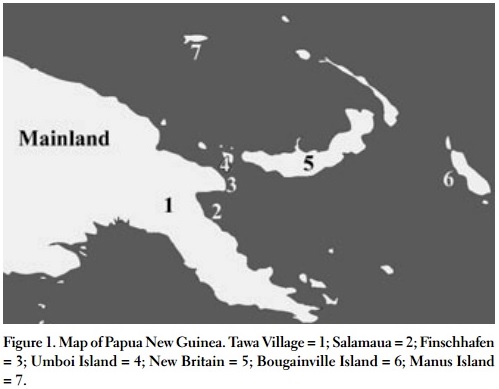
Page 3 of the scientific paper (but page in the journal is “202”)
This includes evidence gathered from the two expeditions on Umboi Island in 2004 (Whitcomb and Guessman and Woetzel). It also briefly mentions the expedition of 1994, in which Carl Baugh, Jim Blume, and Paul Nation participated. This page also briefly answers the suggestion that the animal called ropen is not a pterosaur but a bat.
Page 4 of the scientific paper by Whitcomb
This is mostly two tables about what was learned in six expeditions in Papua New Guinea in the following years: 2002, 2004, 2006, and 2007. Here are some examples of what was learned about the ropen, according to natives:
- “ropen never glows longer than 5-6 seconds at a time”
- “the ropen may be similar to a Sordes pilosus (but ropen is large)”
- “tail length is 7 m [23 feet]; mouth ‘like a crocodile’ . . .”
- “has a long tail with a ‘diamond’ . . . Lake Pung”
- grave robbery in the village of Gomlongon (Umboi Island)
- “large empty clam shells . . . the ropen eats clams”
Page 5 of “Reports of Living Pterosaurs in the Southwest Pacific”
The following are some examples from Table II:
- Finschhafen — 1944 — Giant, long beak & tail, head appen.”
- Umboi — 1972 — “Gov’t official sees light fly near Lab Lab”
- Bougainville — 1971 — “Long beak, long tail, head appendage”
- Umboi — “upright, it holds onto a tree trunk”
Page 6 of the scientific paper
This has the continuation of Table II and all of Table III. Here are a few examples from this page, restricted to flying lights on Umboi Island:
- Umboi — 2003 — “it flew from beach to [the mountain] Bel”
- Umboi — 2003 — “light flew down to reef, as if fishing”
- Umboi — 2004 — “creature glowing as it flew”
- Tawa Village — 2006 — “two lights on a ridge (videotaped)”
- Tawa area — 2006 — “winged creature sleeping on a cliff”
Books on Modern Pterosaurs
The preceding references to images of pages of that scientific paper can be used in finding the other pages, up to the final one: page thirteen.
I recommend my book Searching for Ropens and Finding God, which is the longest nonfiction print publication on living pterosaurs. For young readers, especially those between eight and fourteen years old, I recommend my shorter book: The Girl who saw a Flying Dinosaur.
###
.
Scientific paper on living pterosaurs
Eyewitness sightings in “Reports of Living Pterosaurs in the Southwest Pacific,” include the sighting by Duane Hodgkinson, the World War II veteran. This excerpt is from Volume 45, Number 3, of the Creation Research Society Quarterly (Winter issue, 2009).
.
Nonfiction cryptozoology books
Six books that have at least some content related to sightings of apparent living pterosaurs—that’s what this blog post covers.
.
Scientific papers about modern pterosaurs
Two peer-reviewed articles are covered here, one by David Woetzel and the other by Jonathan Whitcomb:
- “The Fiery Flying Serpent”
- “Reports of Living Pterosaurs in the Southwest Pacific”
.
Non-fiction books on living pterosaurs
Two paperback books are closely compared:
- Searching for Ropens and Finding God (4th edition)
- Live Pterosaurs in America (3rd edition)
.
Modern pterosaurs in Papua New Guinea
Around 1965, some of the natives in this general area of New Britain got access to a gun and shot a pterosaur. They then cooked it in three large pots, feeding the village. This event was told to [Milt Marcy] and [Peter Beach] by two of the older natives, Fraggie and Hulio, who were boys at the time of the feast. Apparently, however, Marcy and Beach stayed in a different village than the one in which Fraggie and Hulio remembered enjoying that home-cooked meal.
.
Scientific paper on non-extinct pterodactyls (& a sighting in Spain)
Let’s examine an individual sighting report and its credibility: an account of an apparent living pterosaur in Spain. (I’ve already written much about the overall honesty-credibility of the reports, so we’ll here concentrate on this individual account.)
.
Cryptozoology book on pterosaurs
“Since the time of Darwin, many scientists have assumed that some general types of animals became extinct long ago. One of the assumptions is that all species of dinosaurs and pterosaurs died off before any humans existed.” [from Jonathan Whitcomb]
.
